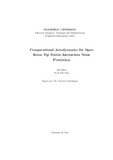JavaScript is disabled for your browser. Some features of this site may not work without it.
| dc.contributor.advisor | MacManus, David G. | |
| dc.contributor.author | Elson, Tom | |
| dc.date.accessioned | 2017-08-09T13:13:23Z | |
| dc.date.available | 2017-08-09T13:13:23Z | |
| dc.date.issued | 2015-11 | |
| dc.identifier.uri | http://dspace.lib.cranfield.ac.uk/handle/1826/12294 | |
| dc.description.abstract | Open rotor engines can provide fuel savings of up to twenty seven percent compared to a modern high bypass turbofan engine. They were subject to intense research in the 1980s in response to the 1973 oil crisis. They have come back into consideration to combat the strict environmental regulations currently imposed on the aviation industry and to meet the ACARE 2020 requirements. Recent large scale European projects such as DREAM and Clean Sky have included signi cant research on the open rotor since their comeback. Their major drawback is the noise levels generated when the wake and tip vortices of the front rotor interact with the aft rotor. The noise generated from these interactions is highly tonal which makes the open rotor prohibitively noisy. The Unducted Fan (UDF) demonstrator engine was built in the 1980s by General Electric in collaboration with NASA. During the design phase of this project a computer code named CRPFAN was developed to predict the noise of open rotors. CRPFAN is used as a representative preliminary design noise prediction tool and was the only representative tool available to the author at the time of the project. Included in CRPFAN is a vortex model which relies heavily on outdated empirical re- lations. There is currently a better knowledge of tip vortex properties relative to when the code was created. However, there has been no signi cant study on how the speci c parameters of a tip vortex relate to the noise of an open rotor or how to more accurately predict the tip vortex parameters, which is what this project aims to do. The rst part of the project developed methods to quantify how the tip vortex param- eters relate to the noise generated by its interaction with the aft blade row. The next step was to further develop the state of the art of tip vortex models. This is done using basic analytical models integrated into CRPFAN and the use of Computational Fluid Dynamics (CFD) to model the tip vortices. CFD was used to develop bespoke tip vortex correlations which relate the tip vortex parameters to the open rotor performance parameters such as the lift, thrust and power coe cients. Correlations for the tip vortex axial velocity, trajectory, circulation and core size have been developed and integrated into CRPFAN with a detailed analysis of their performance relative to the current state of the art included. This thesis includes recommendations to improve the tip vortex models such as taking into account the spatial orientation of the vortex, inclusion of a vortex axial velocity component and how strip theory codes can under predict the noise. | en_UK |
| dc.language.iso | en | en_UK |
| dc.publisher | Cranfield University | en_UK |
| dc.rights | © Cranfield University, 2015. All rights reserved. No part of this publication may be reproduced without the written permission of the copyright holder. | en_UK |
| dc.title | Computational aerodynamics for open rotor tip vortex interaction noise prediction | en_UK |
| dc.type | Thesis or dissertation | en_UK |
| dc.type.qualificationlevel | Doctoral | en_UK |
| dc.type.qualificationname | PhD | en_UK |
